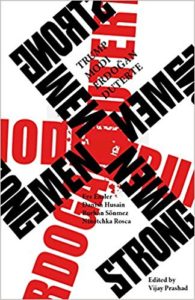“Strongmen” by Eve Ensler, Danish Husain, Vijay Prashad
 Strongmen is a slim book, a collection of fables about strong men. As the book blurb says “Eve Ensler, the American playwright (The Vagina Monologues), goes beneath the skin – or should we say orange hair – of US President Donald Trump. Danish Husain, the Indian storyteller and actor, finds himself telling us the story not only of Indian Prime Minister Narendra Modi but also of the ascension of the extremism of the Sangh Parivar. Burhan Sönmez, the Turkish novelist, ferrets about amidst the bewildering career of the Turkish President Recep Tayyip Erdoğan. Ninotchka Rosca, the Filipina feminist novelist, unravels the macho world of Rodrigo Duterte. Their essays do not presume to be neutral. They are partisan thinkers, magical writers, people who see not only the monsters but also a future beyond the ghouls. A future that is necessary. The present is too painful.”
Strongmen is a slim book, a collection of fables about strong men. As the book blurb says “Eve Ensler, the American playwright (The Vagina Monologues), goes beneath the skin – or should we say orange hair – of US President Donald Trump. Danish Husain, the Indian storyteller and actor, finds himself telling us the story not only of Indian Prime Minister Narendra Modi but also of the ascension of the extremism of the Sangh Parivar. Burhan Sönmez, the Turkish novelist, ferrets about amidst the bewildering career of the Turkish President Recep Tayyip Erdoğan. Ninotchka Rosca, the Filipina feminist novelist, unravels the macho world of Rodrigo Duterte. Their essays do not presume to be neutral. They are partisan thinkers, magical writers, people who see not only the monsters but also a future beyond the ghouls. A future that is necessary. The present is too painful.”
With the permission of the publisher here is an extract from Eve Ensler’s essay:
This is the story of what happened in the late time, right before the end time, that later got interrupted and became the new time. In those days there arrived in the land of violent amnesia and rapacious dreams – a virus. It first became discernible in an oafish, chubby man with orange hair. Some say it was the virus that turned his hair orange. Others claimed his hair was actually the virus. The oafish, chubby man with orange hair goes on to become the most powerful man in the world.
It was highly debated whether the intensity of the infection was the cause of his rise, but it has since become clear that the virus was a very contagious one and that much of the populace had a dormant strain of it lodged in their beings which was activated by the orange man during his toxic campaign.
Those infected the most deeply were those with unexamined wounds and openings from childhood, repressed fear, insecurities that were ripe for othering and rage, predisposition towards racism and sexism and insatiable daddy hunger. These tendencies were exacerbated and catalyzed by the way the portly, thuggish leader injected the virus into the unsuspecting crowds through angry white-hate filled spittle, slimy superlatives, sham filled promises, and toxic red caps which allowed the virus to seep in through the hair follicles and head. Bald men were most susceptible.
This, fortunately, was not true of all segments of the population because some appeared to have built-in immunity. Most of those were the ones who lived on the various edges, which was ironic, as it was the ones most foreign and exiled from the culture who would eventually find a cure. We will come to that later.
It was also highly debated whether the man with orange hair was the origin of the virus or simply the manifestation of it. Some said it didn’t matter, but I believe it matters a lot. For if the chubby man were the originator of the virus, then it would have simply been one sick individual contaminating the public and if and when he was eliminated, the virus, would, in theory, be gone as well. But we know this didn’t happen. So the question then evolved: why was the oafish, portly man with orange hair the major host of the virus?
And again, the theories abound.
One classic theory is that the thuggish man had become what no one had yet become in the time of late date consumption and greed. He had evolved or devolved (depending on your perspective) into what the psychologists later came to define as a genocidal narcissist – a person willing and able to destroy everyone and everything on the planet as long as it makes him feel momentarily better. That extreme and total endgame narcissism made the oafish man a perfect super host for the virus. For it has since been discovered that the virus can only fester in an environment where the host has developed no antibodies to tolerate others, or indeed criticism, difference, curiosity, questions, doubt, ambiguity, the truth, mystery, waiting, thinking, reading, reflecting, questioning, wondering, caring, feeling, listening, or studying. It is where the healing properties of humour and irony have been killed off and self-obsession, revenge and self-adulation have taken their place.
Noted symptoms of the virus are: hysteria, mania, illogical thinking, impulse disorder, bullying, a distorted belief that the group and gender you belong is superior, vile and show-offy compulsive grabbing, molesting behaviour towards women, compulsive lying, increased paranoia, loss of ability to distinguish between good and evil (for example equating Nazi and white supremacist with people fighting for their constitutional rights) and shifting and constantly evolving enemies, because the infection needs a target to energize its effective components. One day it was Mexicans, the next day blonde women reporters, the next a Puerto Rican mayor, the next Black football players. It was actually irrelevant to the virus who the enemy was as long as it kept shifting and escalating as the pathogen craved and fed off this antagonistic energy. But it has been conclusively determined that the virus would first seek already existing weaknesses in the DNA of the culture.
Also read an interview with Eve Ensler with Vinutha Mallya, published in Pune Mirror.
14 August 2018









